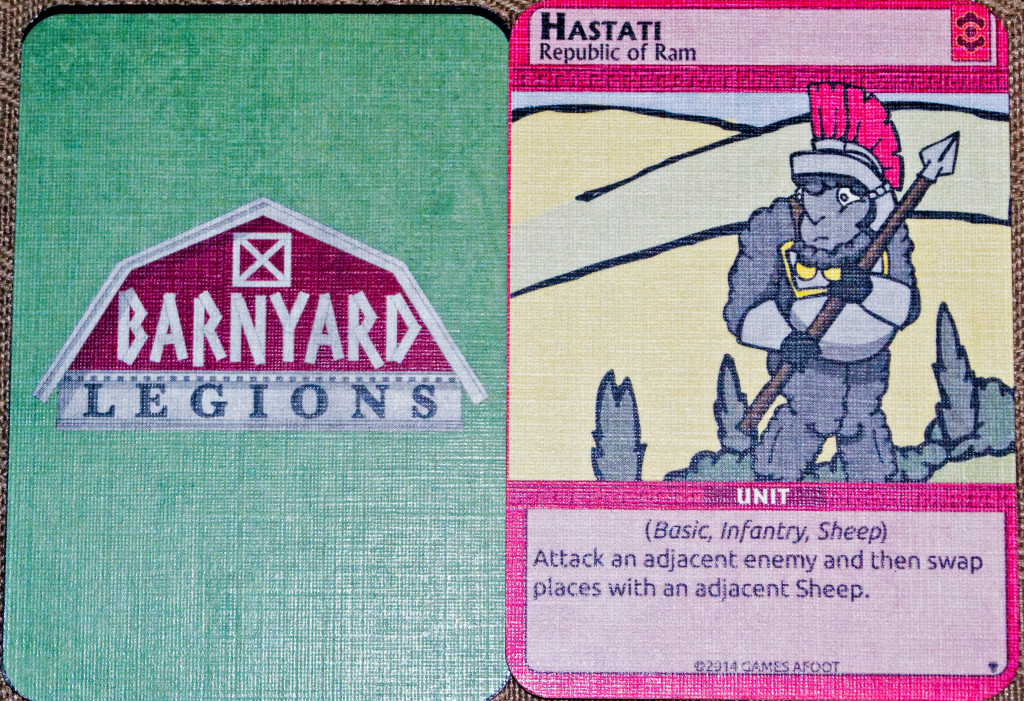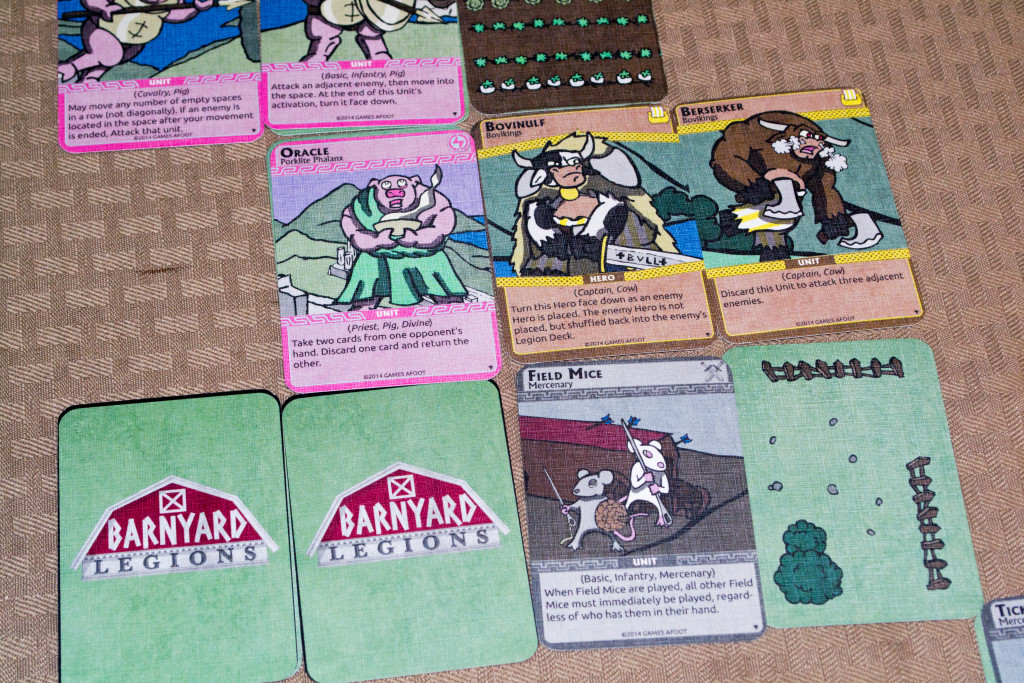I haven’t met a person who didn’t know how to play “Tic-Tac-Toe” and I have yet to meet someone who actually enjoys playing it. Why? The game is just way too simple and if both players are paying an ounce of attention, the end results will be the same: “draw”, “draw”, “draw”. BORRRRING! “Barnyard Legions”, a game that’ll be seeking funding through the Kickstarter process in April of 2015, spices up the idea of “Tic-Tac-Toe” by introducing barnyard factions and cards with special abilities. Before I go any further, I’d like to thank Patricia Meredith from Games Afoot for reaching out and providing me with a prototype for preview purposes. It’s important to stress that prototypes are not often reflective of the final product, making everything featured here (including the rules) subject to change.
The game includes 160 Legion Cards (35 of each of the four factions and 20 Mercenary cards) and 12 Barnyard Cards. Each of the four factions (Republic of Ram, Porklite Phalanx, Celtucky Chickens, and Bovikings) have their own color-coded deck, though the backs are all the same so that players can’t tell which cards belong to what faction. Four of the barnyard cards act as borders for the 6×6 playing area (one for each of the four corners). The rest of the barnyard cards get placed in an “X” like pattern, with four being placed in the very center of the grid. The rest of the spaces in the 6×6 grid remain empty, at least at the start.
Each players chooses a faction and shuffles that corresponding deck appropriately. Players then remove fifteen at random from their own deck and mix them in the with the neutral mercenary deck to form a common draw pile. In other words, players may end up drawing legion cards belonging to their opponents as they play the game. Eight of these cards are drawn from the common deck and placed face down onto the eight center-most barnyard cards (every card that is not a border card). At the start of the game, players draw five cards from their legion deck and three cards from the common deck to form their starting hand.
The game is played over a series of rounds and each round will begin with the same player. At the beginning of each round (except for the first one), players will draw a card from their legion deck. On a player’s turn, they’ll be able to take a total of TWO actions: 1) Turn any face-down card face-up, 2) Draw one card from their legion deck, 3) Draw two cards from the common deck, 4) Play a card from their hand, and 5) Take an action with a mercenary or legion-specific unit. These actions in themselves aren’t that complicated, though the latter ones do include some extra caveats and rules that deserve some special attention.
For example, players can only play cards from their hands that belong to their Legion or cards that are listed as “mercenary”. Another small rule is that players can only play unit cards onto an empty barnyard card OR onto an open space adjacent to another card that is either face-up or face-down (including barnyard cards). Since there are a few spaces that are not adjacent to barnyard cards, players will have to work to chain the cards to those locations. Tactic cards are simply used for their ability and then discarded (unless otherwise specified.
Another interesting tidbit is that players can activate units already on the grid…and by activate, I mean either move them or use their special ability. Again, players can only activate units from their own legion or units listed as “mercenary”. Moving simply involves sliding the card horizontally or vertically (unless otherwise specified) onto an empty space so that it still shares an edge with another card. Of course, you can opt to use a special ability or “basic attack” instead. Basic attacks are ways for players to remove enemy cards from the grid.
While players are limited to two actions on their turn, they can discard a card from their hand to take a third. The player who lays the 5th unit/hero from their legion in a row of five (diagonally, horizontally, or vertically) wins the game. Tactic cards don’t count unless otherwise specified or if it has the keyword, “scoring”. A player can be eliminated if they draw the last card from their legion deck, making it a good idea to draw from the common deck from time to time (even if it means you’ll draw cards of another faction).
“Barnyard Legions” is a pretty interesting concept, taking “Tic-Tac-Toe” to a whole new level. The most difficult part of the game is getting used to what all of the cards do, though casual players will be pleased to know that these card effects aren’t as complicated as say, “Magic: The Gathering”. I thought it was odd that two of the colors used in my prototype were “pink” and “light red”…it made distinguishing between the two factions a little difficult without reading the faction’s name on the card. Instead of pink, I would have gone for something like yellow or black. Again, my copy was a prototype, so perhaps this will be addressed later down the road. Still, the project is worth checking out if you have kids and/or enjoy light card games.
—
You can learn more about and support “Barnyard Legions” by visiting its Kickstarter page, here:
https://www.kickstarter.com/projects/gamesafoot/barnyard-legions


